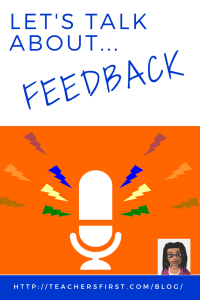Teachers know how important it is to give students feedback on their work. Feedback can help students improve their skills, learn from their mistakes, and achieve their goals. Many articles, books, and workshops can help you as a teacher to learn to give constructive, specific, actionable, and respectful feedback. Here at TeachersFirst, we’ve looked at providing student feedback before, and we also have an OK2Ask session that will help you work through that process using digital tools.
There are some details about feedback that we should promote more. One important thing for teachers to remember is that feedback is a loop. First, we need to respond to the work our students submit, but then the student needs to be prepared to accept the feedback and use it as part of their instruction. The ability to get and learn from feedback is a skill that can be grown and cultivated. It builds resilience and helps prepare students to enter the workforce. So how do you help students learn to use the feedback you give them?
It’s essential first to make sure that students understand what feedback is. Students may need help to see these comments for what they are…an opportunity to grow. This growth can happen in several ways, but students may only see feedback negatively without instruction on making the most of it. Next, share examples with students demonstrating how feedback is helpful by comparing a sample of original and revised work after using feedback to improve.
Feedback can make a student uncomfortable, so plan to address the social-emotional learning component head-on. Using feedback to grow requires the student to engage with a comment and make choices on how to use it. Students can’t grow from feedback if they cannot manage their feelings about what has been said. Help students to learn why the feedback may have made them uncomfortable. Do they feel the statement is untrue? Does the message “sting” because of who made it? Or does it challenge the student’s sense of who they are? These reactions can block the student’s ability to use the feedback constructively. Identifying the feeling and its cause can allow the student to move on to thinking critically about the message and plan how to respond.
Teaching students about the types of feedback can assist them in thinking critically about how to use the comments they receive. Rephrasing a statement can also help the student better understand what has been said. For example, students looking to improve their work may get frustrated by a comment that appreciates their work rather than coaches them on making it better. Using a graphic organizer can guide the student to understand the type of feedback received and thoughtfully consider their next steps.
Closing the feedback loop with students can take time and effort. Modeling with verbal comments or role-playing may be a way to ease them into the critical thinking required to grow from feedback. How do you use feedback in your classroom? Do your students understand how it helps them grow? Share your thoughts in the comments below.


